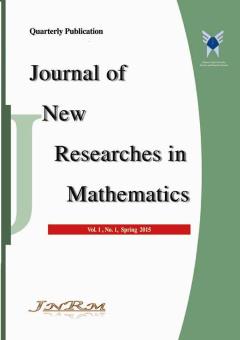Value efficiency based on semi-additive production technology in DEA
Subject Areas : تحقیق در عملیات
1 -
Keywords: تحلیل پوششی دادهها, تابع ارزشی, کارایی ارزشی, تکنولوژی تولید شبه جمعی,
Abstract :
Value efficiency obtain the efficiency of decision-making units in data envelopment analysis (DEA) by incorporating a Decision Maker's (DM) a priori knowledge into the analysis. In this regard, we can consider different production technologies in DEA. One of these technologies is semi-additive production technology. The semi-additive production technology based on the observation decision making units and the set of aggregations units corresponding with these units. In this paper, we first introduce the concepts of value efficiency and semi-additive production technology and then calculate the value efficiency of decision-making units in the semi-additive production technology. We show that the value efficiency scores that calculate based on the semi-additive production technology is different from the value efficiency scores of other technologies and we can calculate the correct score of value efficiency. In the following, we compare the proposed approach in this paper with previous approach for measuring value efficiency to a case study related to data sets from banks in Finland, and finally we bring the results of the research.
[1] A. Chares, W.W. Cooper and E. Rhodes,“Measuring the efficiency of decision-making units, “ Eur. J. Oper. Res., vol. 2, pp. 429-444, 1978.
[2] W. D. Cook and L. M. Seiford, “Data envelopment analysis (DEA)–thirty years on, “ Eur. J. Oper. Res., vol. 192, pp. 1–17, 2009.
[3] J. S. Liu, L. Y. Lu, W-M. Lu and B. J. Lin, “A survey of DEA applications, Omega., vol. 41, pp. 893–902, 2013.
[4] A. Emrouznejad and G. L. Yang, “A survey and analysis of the first 40 years of scholarly literature in DEA: 1978–2016, “ Socio-Econ. Plan. Sci., Vol. 61, pp. 4–8, 2018.
[5] R. D. Banker, A. Charnes and W. W. Cooper,“Some Model for Estimating Technical and Scale Inefficiencies in Data Envelopment Analysis, “ Management Science., Vol. 30, pp. 1078-1092, 1984.
[6] T. C. Koopmans, “Activity analysis of production and allocation. An analysis of production as an efficient combination of activities, “ New York: Wiley, 1951.
[7] D. Deprins, L. Simar and H. Tulkens,“Measuring labor-efficiency in post offices, Public goods, environmental externalities and fiscal competition,“ Springer, 2006.
[8] N. C. Petersen, “Data envelopment analysis on a relaxed set of assumptions, “Management Science., vol. 36, pp. 305–314, 1990.
[9] Ch. Kao, “Measuring efficiency in a general production possibility set allowing for negative data, “ Eur. J. Oper. Res., vol. 282, no. 3, pp. 980-988, 2020.
[10] Ch. Kao, “Measuring efficiency in a general production possibility set allowing for negative data: An extension and a focus on returns to scale, “ Eur. J. Oper. Res., vol. 296, no.1, pp. 267-276, 2022.
[11] Q. Zhu, J. Aparicio, F. Li, J. Wu and G. Kou, “Determining closest targets on the extended facet production possibility set in data envelopment analysis: Modeling and computational aspects, “ Eur. J. Oper. Res., vol. 296, no.3, pp. 927-939, 2022.
[12] R. H. Green and W. D. Cook, “A free coordination hull approach to efficiency measurement, “ J. Oper. Res. Soc., vol. 55, pp. 1059–1063, 2004.
[13] M. Ghiyasi, “A DEA production technology and its usage for incorporation of collaboration in efficiency analysis: an axiomatic approach,“ Int. Trans. Oper. Res., vol. 26, pp. 1118–34, 2016.
[14] M. Karami Khorramabadi, M. Yarahmadi and M. Ghiyasi, “Cost Efficiency Evaluation Based on a Data Envelopment Analysis Approach by Considering Undesirable Outputs on the Basis of the Semi-Disposability Assumption,“ Math. Comput. Appl., vol. 25, no. 1, pp. 4, 2020.
[15] M. Ghiyasi and W. D. Cook,“Modelling the semi-additive production technology in DEA,“ Omega., vol. 103, pp. 102385, 2021.
[16] M. Zohrehbandian, “Using Zionts–Wallenius method to improve estimate of value efficiency in DEA, “ Appl. Math. Model., vol. 35, pp. 3769-3776, 2011.
[17] J. Gerami, “An interactive procedure to improve estimate of value efficiency in DEA, “ Expert Sys. Appl., vol. 137, pp. 29–45 2019.
[18] M. Halme, T. Joro, P. Korhonen, S. Salo and J. Wallenius,“A value efficiency approach to incorporating preference information in data envelopment analysis, “ Manag. Sci., vol. 45, no. 1, pp. 103–115, 1999.
[19] M. Halme, T. Joro and P. Korhonen, “Restricting weights in value efficiency analysis, “ Eur. J. Oper. Res., vol. 126, pp. 175–188, 2000.
[20] T. Joro, P. Korhonen and S. Zionts, “An interactive approach to improve estimates of value efficiency in data envelopments analysis, Eur. J. Oper. Res.,vol. 149, pp. 688–699, 2003.
[21] J. Eskelinen, M. Halme and M. Kallio, “Bank branch sales evaluation using ex- tended value efficiency analysis, “ Eur. J. Oper. Res., vol. 232, pp. 654–663, 2014.
[22] M. Halme P. Korhonen and J. Eskelinen, “Non-convex value efficiency analysis and its application to bank branch sales evaluation, “ Omega., vol. 48, pp. 10–18, 2014.
[23] J. Gerami, M. R. Mozaffari, P. F. Wanke and H. L. Correa, “A generalized inverse DEA model for firm restructuring based on value efficiency, “ IMA J. Manag. Math., vol. 34, no. 3, pp. 541–580, 2023.
[24] G. R. Jahanshahloo, F. Hosseinzadeh Lotfi, H. Zhiani Rezai and F. Rezai Balf, “Finding strong defining hyperplanes of Production Possibility Set, “ Eur. J. Oper. Res., pp. 177, no 1, pp. 42-54, 2007.
[25] F. Hosseinzadeh Lotfi, G. R. Jahanshahloo, M. R. Mozaffari and J. Gerami,“Finding DEA-efficient hyperplanes using MOLP efficient faces, “J. Comput. Appl. Math., vol. 235, no. 5, pp. 1227-1231, 2011.
[26] A. Ghazi, F. Hosseinzadeh Lotfi and M. Sanei, “Finding the strong efficient frontier and strong defining hyperplanes of production possibility set using multiple objective linear programming, “ Oper. Res., vol. 22, no. 1, pp. 165-198, 2022.
[27] J. Eskelinen and T. Kuosmanen, “Intertemporal efficiency analysis of sales teams of a bank: stochastic semi-nonparametric approach,“ J. Bank. Finance., vol. 37, no. 12, pp. 5163–75, 2013.


